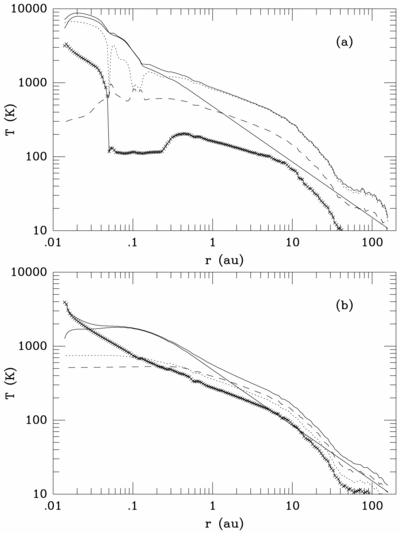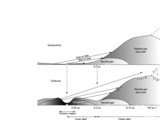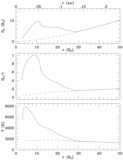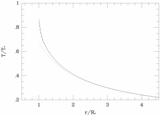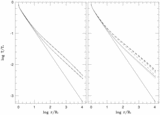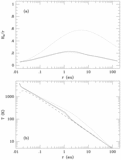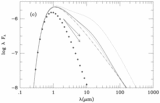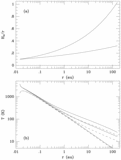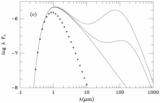Image Details
Caption: Fig. 11.
Temperature profiles for (a) outbursting and (b) quiescent detailed models. Upper solid line: total disk surface temperature, ﹩T_{e}﹩, of detailed model after five disk‐to‐disk reprocessing iterations. Lower solid line: disk accretion temperature, Tacc. This figure investigates the relative contributions of photons originating in (1) inner disk (dotted lines), (2) outer disk (dashed lines), and (3) central star (crosses). Division between inner and outer disks occurs at about 0.25 AU. Using the detailed disk shape, three models are calculated in which only one of these three regions has any intrinsic luminosity. For the other regions, ﹩T_{\mathrm{init}\,}﹩ is set to zero. The full reprocessing simulation is then performed with five iterations. This figure shows the resulting, reprocessing component of the temperature profile: ﹩T_{\mathrm{rp}\,}\equiv ( T^{4}_{e}-T^{4}_{\mathrm{init}\,}) ^{1/ 4}﹩. The stellar component is negligible for the outbursting disk and dominates in the quiescent disk only at ﹩r\lesssim 0.1﹩ AU. Most of the reprocessing in the model in outburst (a) is due to photons that originate in the inner disk (dotted lines). In contrast, for the quiescent model (b), beyond a few tenths of an AU, reprocessed energy is dominated by photons emitted originally by the constant mass flux, outer disk (dashed lines). Throughout most of the disk, the latter component is essentially the same during outbursting and quiescent phases. In both cases, reprocessed energy dominates over the locally generated energy throughout most of the disk.
Copyright and Terms & Conditions
© 1999. The American Astronomical Society. All rights reserved. Printed in U.S.A.


